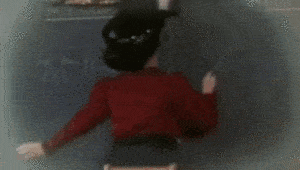It’s almost impossible for most of us to competently edit our own work. I know I can’t do it well, although I do attempt it occasionally. (This blog, for example, is not edited by anyone but moi. Read at your own risk.)
If you haven’t experienced the exquisite torture of a good, hard edit, here’s what you need to know.

 Know this: That won’t ever happen. Your story is going to come back ALL CUT UP.
I get it.
It feels awful.
You open that file and are greeted with so many strikethroughs, insertions, queries, and comments. (So many … so many … so many …) It’s like a red pen bled, threw up, and took a big ol’ dump all over your baby.
No matter how gentle the editor has been, you want to curl up in a weepy, illiterate ball, or maybe kick puppies, if you’re the kind of person who voted for Donald Trump.
Know this: That won’t ever happen. Your story is going to come back ALL CUT UP.
I get it.
It feels awful.
You open that file and are greeted with so many strikethroughs, insertions, queries, and comments. (So many … so many … so many …) It’s like a red pen bled, threw up, and took a big ol’ dump all over your baby.
No matter how gentle the editor has been, you want to curl up in a weepy, illiterate ball, or maybe kick puppies, if you’re the kind of person who voted for Donald Trump.
 It happens to everyone. It happens to me, it happens Jonathan Fucking Franzen, it happens to J. K. Rowling. (It doesn’t, apparently, happen to Anne Rice, but it definitely should. Just sayin’.)
Then, if you’re any sort of writer at all, you down a few drams of Scotch, or cups of tea, or shots of Red Bull, or whatever cleans your pipes, and you wipe your nose and park your butt back in that chair. Because you’ve got deadlines, baby, and unless you’re actually Douglas Adams, you can’t afford to listen to the sound of them whooshing by.
Okay? Okay.
So, we’ve established that the editing process hurts. Sometimes it hurts more, sometimes less, but there’s just no good way around it, so you might as well suck it up and get on with the business of getting some shit down on paper.
So how does this editing thing really work?
It happens to everyone. It happens to me, it happens Jonathan Fucking Franzen, it happens to J. K. Rowling. (It doesn’t, apparently, happen to Anne Rice, but it definitely should. Just sayin’.)
Then, if you’re any sort of writer at all, you down a few drams of Scotch, or cups of tea, or shots of Red Bull, or whatever cleans your pipes, and you wipe your nose and park your butt back in that chair. Because you’ve got deadlines, baby, and unless you’re actually Douglas Adams, you can’t afford to listen to the sound of them whooshing by.
Okay? Okay.
So, we’ve established that the editing process hurts. Sometimes it hurts more, sometimes less, but there’s just no good way around it, so you might as well suck it up and get on with the business of getting some shit down on paper.
So how does this editing thing really work? In the professional world, most books go through several different types of editing, and (surprise!) no one completely agrees on their definitions. Each editor defines these a little differently, but here are the basics:
Developmental (aka substantive) editing evaluates the story as a whole, looking for big-picture things like plot, pacing, character and theme development, voice, etc. After receiving a developmental edit, the author usually has some major revision, or even a rewrite, to do. After this stage, they may continue to work with the developmental editor and go through one or more additional rounds of edits before moving on to the next stage of editing.
Copyediting and line editing are sometimes conflated or done together (which is my general practice), but they serve two distinct purposes.
Copyediting is a technical review of a manuscript, making sure it follows the rules of good communication. It susses out grammatical and punctuation errors, continuity and consistency problems, and other largely mechanical issues that can affect a reader’s comprehension of a story.
Line editing looks at how the author uses language to tell a story. A line editor makes suggestions to improve paragraph structure and pacing, word choice, vibrancy, variation, and other language issues that affect a reader’s experience of reading the story.
Proofreading is the last stage of producing a story. It’s the final quality check to find problems, such as textual inconsistencies, spelling or punctuation errors, or other technical issues before the story goes to publication.
Unless you’re already a professional author, you probably don’t have the luxury of having a professional editor to read your work. Your best bet, of course, is to hire one. Jane Friedman has some great tips on finding an editor if you’re an independent author.
If you’re a fanfic author, however, you’re probably not going to want to spend the money (unless you’re independently wealthy, in which case, you definitely should support your local editor).
Fortunately, there are a few things you can do to make sure your Snarry baby!fic doesn’t fall flat because you can’t get your goddamn commas to behave.
I use two programs for my own writing and with editing clients’ work. These aren’t a substitute for a human editor, but they are useful for flagging common issues that plague most writers. (Use them with caution, however; their suggestions aren’t always correct or beneficial.)
ProWritingAid is great for basic editing tasks like checking for repeated words and phrases, sentence variation, and overused words. There’s a free online version that allows you to upload limited amounts of text for checking.
PerfectIt is professional-grade copyediting software. It contains more robust checkers than ProWritingAid, and when integrated with a Word installation, it has powerful tools like custom style sheets that make editing for a variety of styles easier.
Better than software, peer editors and beta readers are a good alternative if you don’t have acceess to a pro. Many archives and posting sites have forums where you can find a beta reader or editor. Here again, caveat emptor—most betas and editors on these sites are passionate about writing, but they aren’t pros, so you’ll want to make sure anyone you work with knows their independent clause from their comma splice.
Decide on a standard dictionary to use and refer to it when there are several potential spellings of a word. Note anything you choose to spell differently from your dictionary’s first choice in your style sheet.
Learn to use your word-processing program’s revision function. (In Word, for example, this is the “Track Changes” feature.) It makes the back and forth of editing much smoother.
Following these guidelines will go a long way to making your story, if not better, more polished and comprehensible, which is an accomplishment in a world full of the slapdash and unreadable.
Happy scribbling!

Lorem ipsum dolor sit amet, consectetur adipiscing elit. Ut elit tellus, luctus nec ullamcorper mattis, pulvinar dapibus leo.